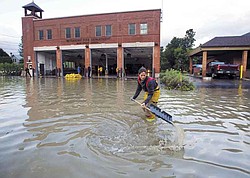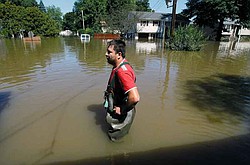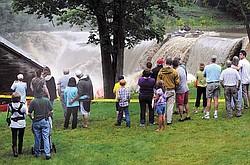Irene brings worst flooding in century to Vermont
Firefighter Mandy Drake clears a storm drain in front of the fire department in Waterbury, Vt., in the wake of Irene on Monday.
Gino Borova stands in the driveway of his house in Pompton Lakes, N.J., where the Ramapo River crested in the aftermath of Hurricane Irene. Borova has lived in the house for six months and has seen two floods damage his property.
Residents watch as water rushes over the Ascutney Mill Dam on Kennedy’s Pond in Windsor, Vt. A weakened but dangerous Tropical Storm Irene dumped up to half a foot of rain in places, flooded roads, knocked down trees and left more than 165,000 Vermont homes and businesses in the dark before blowing out of the state Sunday.
Associated Press
WATERBURY, Vt.
Almost a dozen New England towns were rendered virtual islands Monday as floodwaters from the remnants of Hurricane Irene reshaped parts of Vermont and upstate New York, turning placid rivers into raging torrents and some streets into treacherous mud bogs.
Hundreds of roads remained closed, dozens of bridges were gone and entire towns were cut off from assistance in the worst flooding some areas have seen in a century.
A day earlier, Irene dumped up to 11 inches on parts of Vermont and more than 13 inches on some areas of New York — a deluge that quickly overwhelmed waterways, storm sewers and drainage systems. At one point, the floodwaters were rising so fast that Vermont officials feared they might have to take the extraordinary step of flooding the state capital of Montpelier to relieve pressure on a dam.
“We prepared for the worst and we got the worst in central and southern Vermont,” Gov. Peter Shumlin said. “It’s just devastating — whole communities under water. ... We’re tough folks here in Vermont, but Irene really ... hit us hard.”
The destruction was etched across the landscape: highways washed out by fast-moving water, bridges and homes crumpled into heaps of broken planks and streets filled with mud thick enough to stop heavy duty vehicles in their tracks.
The images were much the same in upstate New York, where buildings that had withstood a century of hard winters and spring floods were carried away. The floodwaters upended cars and trucks and sent trees tumbling down rivers like matchsticks.
“We were expecting heavy rains,” said Bobbi-Jean Jeun of Clarksville, a rural hamlet near Albany. “We were expecting flooding. We weren’t expecting devastation.”
The storm was blamed for at least six deaths in New York. Three people were dead in Vermont, and a fourth was missing.
In the Catskills town of Phoenicia, the main street was still covered in red earth Monday, a day after a creek swelled beyond its banks and roared through town.
Chris Smith said the water was 3 feet deep on the street and moving swiftly enough to rock telephone poles. It carried away trees and lawn furniture.
“If you tried to cross the street, you would not have made it. The force you would not believe,” he said. “It was just chocolate milk and trees and park benches.”
The Vermont governor and Sen. Patrick Leahy toured some of the most devastated communities by helicopter Monday, but because the floodwaters cut off many of those towns, the full extent of the damage could take days to emerge. In at least a dozen places, neither utility crews nor emergency vehicles could get in to offer help. President Barack Obama has declared the state a federal disaster area.
Video posted on Facebook showed a 141-year-old covered bridge in Rockingham, Vt., swept away by the roiling, muddy Williams River. In another video, an empty car somersaulted down a river in Bennington.
“I didn’t think the water would ever get that high. I can’t believe it,” said Henry Shattuck of Bellows Falls, Vt., describing the remains of the bridge over the Williams River. “I’ve seen people crying because it’s gone. It hurts me, too, because, like I said, I’ve been over that bridge many, many times.”
Almost 50,000 utility customers were without power, and at least two bodies have been recovered. One was believed to be a woman who fell into the Deerfield River while watching flooding in Wilmington. The other was one of two men lost when they went to inspect the inlet to the city’s water system.
Chris Cole of the Agency of Transportation said part or nearly all of a dozen communities remained unreachable: Bennington, Cavendish, Chester, Granville, Killington, Ludlow, Mendon, Middletown Springs, Rochester, Stockbridge and Wilmington.
As floodwaters pressed on an earthen dam 20 miles north of Montpelier, officials feared they might have to open floodgates that would add to the water pouring into the state capital of Montpelier to relieve pressure. But by Monday morning, the rain eased and with it the strain on the dam.
At the state office complex on the south end of town, offices were empty Monday but a few workers stopped by to check on damage. And one, flooded out of her home across South Main Street, stopped by to take a shower.
Elsewhere, the violent waters caused part of a ski lodge to collapse in Killington, where 300 people were reported stranded. And officials evacuated a state mental hospital in Waterbury, with many of the patients being moved to other hospitals.
 43
43



